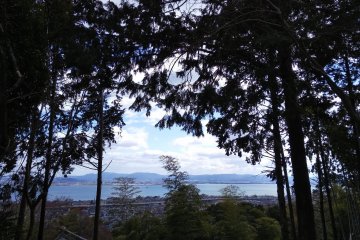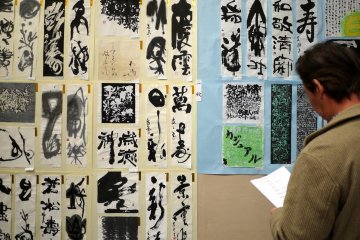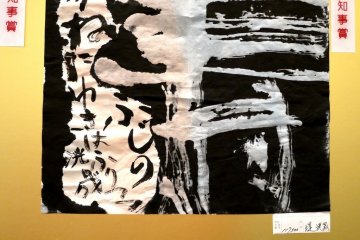Have you ever tried calligraphy? It's a treasured part of Japanese culture, and school children all over Japan experience it as part of the yearly curriculum. Those who like it go on to study it as adults, and it's an integral part of New Year celebrations.
Although I'm interested in both viewing and creating different kinds of art, I just kept saying "I must try that one day". Then one day a few years ago, I was offered a free lesson. That was it! One lesson, and I was totally hooked! Like some other notable art forms in Japan - for example, traditional decor and haiku poetry - shodo (the way of writing) has a deceptive simplicity. White paper, black ink, a brush, and the artist. As I struggled to reproduce the way my teacher wrote 楽 (raku/tanoshii which means pleasure or fun) it was as if a light came on in my brain, and I realized that even though the elements were so simple, the artist could imbue life and energy into the character. I felt the meditative aspect of the art form as well. Painting the character over and over again is like a mantra. It's both soothing and empowering. You are completely in the 'now' moment as you concentrate on the flow of the brush and the shaping of the character. It's wonderful!
Needless to say, I continued taking lessons. I was so fortunate in my teacher, Kitagawa-Sensei. A retired school teacher who continues to teach calligraphy to all ages, he is himself an outstanding calligrapher in abstract style. His skill and artistic expression both awe and inspire me. He headed the Shiga Calligraphy Association for several years, and one of their annual activities is a HUGE exhibition of calligraphy from all over the prefecture, showing the best of the various grades. It's held at Otsu City Museum of History every February, and I can't recommend it enough! It's not like going to an art gallery where a few works are displayed in frames. There are thousands of paper strips or squares hanging side by side, grouped by grade. The work of school children, adult students and professional calligraphers all displayed together in one enormous hall. I was blown away by the sheer variety of the work. There were many different styles, and the paper used also influences the appearance of the calligraphy. It wasn't even all black and white. Colored papers and sometimes colored ink had been used. The best in each grade were marked by silver and gold strips of tape.
The 54th annual Shiga Prefecture Kakizome Tenran-kai will be held at Otsu City Museum of History from 13th -15th February 2015. I think this exhibition shows that calligraphy is one element of traditional Japanese culture that is still vibrantly alive and well. If you practice calligraphy yourself you are sure to find it interesting, and if you don't, maybe you will be inspired to try it!
You can see some more photos here.











